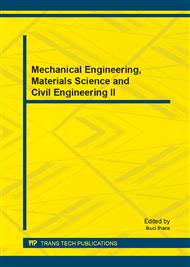p.925
p.930
p.934
p.938
p.942
p.950
p.954
p.958
p.962
Analysis on Consolidation and Settlement Characteristics of Composite Foundation with T-Shaped Bidirectional Soil-Cement Deep Mixing Columns
Abstract:
Based on the solution of one-dimensional consolidation model of T-shaped bidirectional soil-cement deep mixing column composite foundation and its calculating program deduced by the separation of variables and Laplace method. This paper discussed the consolidation and settlement characteristics of composite foundation under the conditions of different loading modes, foundation reinforcement modes, diameter of enlarged pile head and pile spacing. The results indicate, the soil layer in the region of enlarged pile head hardly be influenced by above factors, the lower soil layer and soft substratum soil are influenced greatly. Loading mode has a large effect on the consolidation, when loading instantaneously, the rate of consolidation is faster than that of loading constantly. The consolidation and settlement behavior of composite foundation reinforced by T-shaped bidirectional soil-cement deep mixing column and traditional bidirectional deep mixing column is much better than the original natural foundation. When the other parameters stay the same, consolidation degree and total settlement decrease with the increase of enlarged pile head diameter. With the increase of pile spacing, consolidation rate of the composite foundation decreases significantly, but the settlement value increases rapidly on the contrary.
Info:
Periodical:
Pages:
942-949
Citation:
Online since:
December 2013
Authors:
Price:
Сopyright:
© 2014 Trans Tech Publications Ltd. All Rights Reserved
Share:
Citation:


